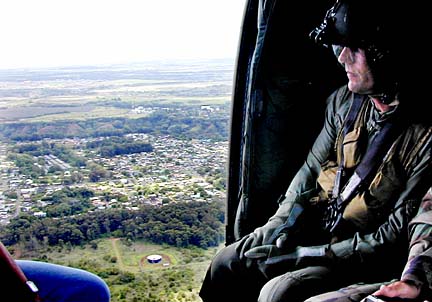Advertisement - Click to support our sponsors.


Neighbors put
Army training
under fire
All-hours action in the
By Harold Morse
East Range riles Mililani
Mauka's newest community
and Gregg K. Kakesako
Star-BulletinMililani homeowner Therese Gagarin knew the new home she and her husband purchased in December was close to Wheeler Army Airfield and its activities as stated in the "military effects" clause in the deed.
"What we were not aware of until after we purchased and moved into our new home with our two children was the unpleasant fact that the loud noise of military exercises can occur at any hour of the day, any day of the week, for any duration, in the East Range," she told the Mililani Mauka/Launani Valley Neighborhood Board last night.

She was among residents saying the noise is not acceptable, but there was at least one, Reinaldo Gonzalez of Mililani Mauka, an ROTC instructor at Nanakuli High School, who said residents should be good neighbors with the military.Officials at Schofield Barracks told reporters at an earlier gathering that Army soldiers need to train at night throughout the week and on weekends, and Mililani Mauka residents and prospective buyers need to be aware that what seems to be vacant land next to their fence line is an active military training area.
Lt. Col. William Bryan, executive officer for the 25th Infantry Division's 3rd Brigade, was responding to the latest complaints from the subdivision being developed by Castle & Cooke Homes.
Alan Arakawa, Castle and Cooke vice president for land development, told the neighborhood board: "We believe that the disclosure was adequate."

Roy Doi, neighborhood board chairman, said the board understands different sides of the East Range situation but the board may not have the power to work out the dispute.At the military news conference, officials said that, in the past, complaints about noise have been sparked by such things as helicopter flights, voices and rifle fire that at times break the still of the night as soldiers train at the barracks' nearly nine-mile-long East Range.
At night, voices and rifle fire tend to travel farther and seem louder, which aggravates some residents of Mililani Mauka. Last month, they brought their complaints to the neighborhood board.
Chief Warrant Officer John Sparkman, standardization officer, 25th Aviation Brigade, noted that as "the suburbs here expand, our Army training areas get crowded and our flight corridors get closer together."
But Sparkman said the Army needs to train and "to stand ready for war and be able to handle two major conflicts on the globe at the same time."
"As night fighters, we need to own the night," Bryan said. "Our weapons system gives us advantage at night, and that's why we have to train at night."
Only small arms, rifles and machine guns and simulators are used in the East Range. No artillery or aerial bursts or use of CS gas are allowed. Aircraft are restricted; they must stay 2,000 feet above the ground at Mililani Mauka.
Bryan said he is recommending that the Army stop using heavy-smoke simulators at one of the sites nearest Mililani Mauka.
Most of the complaints seem to come from the newest subdivision, located on upper portion of the housing development.
Bryan said all complaints of low-flying aircraft are thoroughly investigated and all complainants receive a personal response. He said complaints should contain specific information such as the time and type of aircraft.
At the neighborhood board meeting, Kristine Oh asked the military to come up with a refrigerator magnet that displays a phone number to call to get immediate cessation of noise.